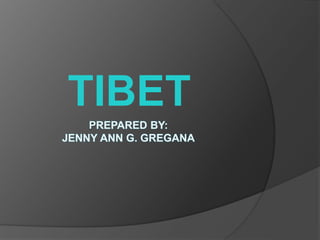
Tibet
- 1. TIBET
- 3. Tibet is a plateau region in Asia, north-east of the Himalayas, in China. It is the traditional homeland of the Tibetan people is the highest region on Earth, with an average elevation of 4,900 metres (16,000 ft). The dominant religion in Tibet is Tibetan Buddhism
- 4. Tibet in addition there is Bön which was the indigenous religion of Tibet before the arrival of Buddhism in the 7th century CE (Bön is now similar to Tibetan Buddhism) though there are also Muslim and Christian minorities. Tibetan architecture reflects Chinese and Indian influences.
- 6. Brief History Humans inhabited the Tibetan Plateau at least 21,000 years ago. This population was largely replaced around 3,000 BP by Neolithicimmigrants from northern China. However, there is a partial genetic continuity between the Paleolithic inhabitants and the contemporary Tibetan populations
- 7. The earliest Tibetan historical texts identify the Zhang Zhung culture as a people who migrated from the Amdo region into what is now the region of Guge in western Tibet. the kings of Tibet were more mythological than factual, and there is insufficient evidence of their existence.
- 9. The history of a unified Tibet begins with the rule of Songtsän Gampo (604– 650 CE) who united parts of the Yarlung River Valley and founded the Tibetan Empire. He also brought in many reforms and Tibetan power spread rapidly creating a large and powerful empire.
- 10. Yuan Dynasty The Mongolian Yuan dynasty, through the Bureau of Buddhist and Tibetan Affairs, or Xuanzheng Yuan (宣政院), ruled Tibet through a top-level administrative department. One of the department's purposes was to select a dpon-chen ('great administrator'), usually appointed by the lama and confirmed by the Mongol emperor in Beijing.The Sakya lama retained a degree of autonomy, acting as the political authority of the region, while the dpon-chen held administrative and military power. Mongol rule of Tibet remained separate from the main provinces of China, but the region existed under the administration of the Yuan Dynasty
- 11. Phagmodrupa Dynasty and the Dalai Lamas Between 1346 and 1354, Tai Situ Changchub Gyaltsen toppled the Sakya and founded the Phagmodrupa Dynasty In 1578, Altan Khan of the Tümed Mongols gave Sonam Gyatso, a high lama of the Gelugpa school, the name Dalai Lama,Dalai being the Mongolian translation of the Tibetan name Gyatso "Ocean".
- 12. The first Europeans to arrive in Tibet were the Portuguese missionaries António de Andrade and Manuel Marques in 1624. They were welcomed by the King and Queen of Guge, and were allowed to build a church and to introduce Christian belief. The king of Guge eagerly accepted Christianity as an offsetting religious influence to dilute the thriving Gelugpa and to counterbalance his potential rivals and consolidate his position. All missionaries were expelled in 1745.
- 13. Geography Tibet has some of the world's tallest mountains, with several of them making the top ten list. Mount Everest, at 8,848 metres (29,029 ft), is the highest mountain on earth, located on the border with Nepal. Several major rivers have their source in the Tibetan Plateau (mostly in present-day Qinghai Province). These include Yangtze, Yellow River, Indus River, Mekong, Ganges, Salween and the Yarlung Tsangpo River (Brahmaputra River).[61] The Yarlung Tsangpo Grand Canyon, along the Yarlung Tsangpo River, is among the deepest and longest canyons in the world.
- 14. Tibet has been called the "Water Tower" of Asia, and China is investing heavily in water projects in Tibet The Indus and Brahmaputra rivers originate from a lake (Tib: Tso Mapham) in Western Tibet, nearMount Kailash. The mountain is a holy pilgrimage site for both Hindus and Tibetans.
- 15. Himalayas, on the southern rim of the Tibetan plateau
- 16. Tibet Lhasa is Tibet's traditional capital and the capital of Tibet Autonomous Region. It contains two world heritage sites – the Potala Palace and Norbulingka, which were the residences of the Dalai Lama. Lhasa contains a number of significant temples and monasteries, including Jokhang and Ramoche Temple.
- 17. Potala Palace
- 18. The theocratic government Prior to assertion of Chinese control over Tibet it was a feudal theocracy headed by the Dalai Lama or a regency and administered by the Kashag, a council of four, and 400–500 officials drawn from the traditional Tibetan aristocracy, Tibetan monasteries, and middle-class families of Lhasa
- 19. Economy The Tibetan economy is dominated by subsistence agriculture. Due to limited arable land, the primary occupation of the Tibetan Plateau is raising livestock, such as sheep, cattle, goats, camels, yaks, dzo, and horses. The main crops grown are barley, wheat, buckwheat, rye, potatoes, and assorted fruits and vegetables. Tibet is ranked the lowest among China’s 31 provinces
- 20. Tourism brings in the most income from the sale of handicrafts. These include Tibetan hats, jewelry (silver and gold), wooden items, clothing, quilts, fabrics, Tibetan rugs and carpets.
- 21. The Central People's Government exempts Tibet from all taxation and provides 90% of Tibet's government expenditures. However most of this investment goes to pay migrant workers who do not settle in Tibet and send much of their income home to other provinces.
- 22. In January 2007, the Chinese government issued a report outlining the discovery of a large mineral deposit under the Tibetan Plateau.The deposit has an estimated value of $128 billion and may double Chinese reserves of zinc, copper, and lead. The Chinese government sees this as a way to alleviate the nation's dependence on foreign mineral imports for its growing economy. However, critics worry that mining these vast resources will harm Tibet's fragile ecosystem and undermine Tibetan culture.
- 23. Historically, the population of Tibet consisted of primarily ethnic Tibetans and some other ethnic groups. According to tradition the original ancestors of the Tibetan people, as represented by the six red bands in the Tibetan flag, are: the Se, Mu, Dong, Tong, Dru and Ra
